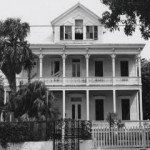Historic District
The Fogarty Mansion
Built in 1887 by Charles Curry, son of William Curry, it's one of the grandest homes built by the Curry children. Dr. Joseph Norman Fogarty purchased the home in 1900 for his bride Corinne, Charles' daughter. Dr. Fogarty served as Mayor of Key West for 6 years and in 1912 held receptions for both President Taft and Henry Flagler, celebrating the completion of the railroad, on his front lawn. 
E.H. Gato Cigar Factory
This is the second Gato cigar factory built on this site. The first structure was a wooden factory built in 1884 and destroyed by fire in 1915. The second factory was built as a hurricane and fire proof structure in 1920. It features large windows and a central open-air courtyard to capture the best light to select premium tobacco leaves. The factory employed 500 cigar artisans and produced sixty thousand hand rolled cigars in 1890. 
Gatoville
Edward H. Gato created one of the first successful industrial communities in the US. By building 40 cigar makers cottages around his cigar factory Gato attracted the most talented workers. The homes were simple two room wooden structures, with a porch facing the street and an outhouse in back. Gato supported the entrepreneurial and community spirit of his workers, encouraging them to start businesses of their own, ranging from groceries and saloons to confectionary shops and private schools.
The Speakeasy
The home was purchased by infamous Prohibition Era rum-runner Raul Vasquez in 1920. During a rum running trip to Cuba Raul brought the elaborately carved balustrade home instead of his usual cargo. The rum and wine bottle balcony fretwork was actually a clever advertisement for “The Florence Clubâ€, Raul’s speakeasy behind the house. When Raul was away an honor system was in place and according to Raul “No one stole a single bottle.â€
The Gato Village Pocket Park
This park was part of a community of 40 cigar makers’ cottages surrounding the Gato Cigar Factory. The structure at the rear of the property is a representation of the cottage that stood here in 1897. The cigar sculpture is believed to be the largest cigar of its type and is a monument to the men and women who made Key West the “cigar capital of the world†in the 1890’s.




